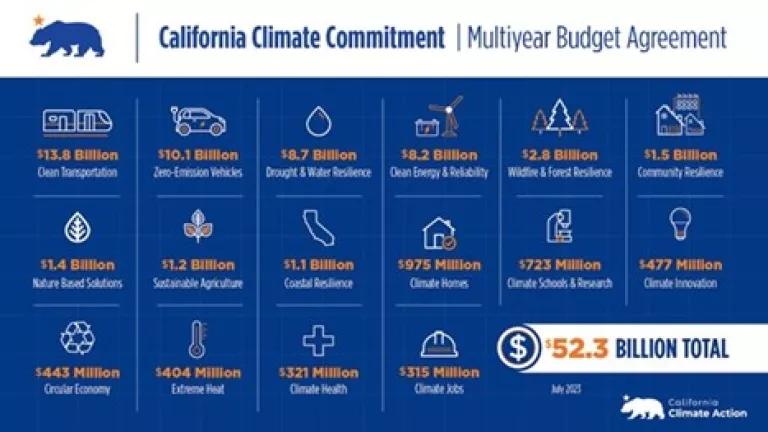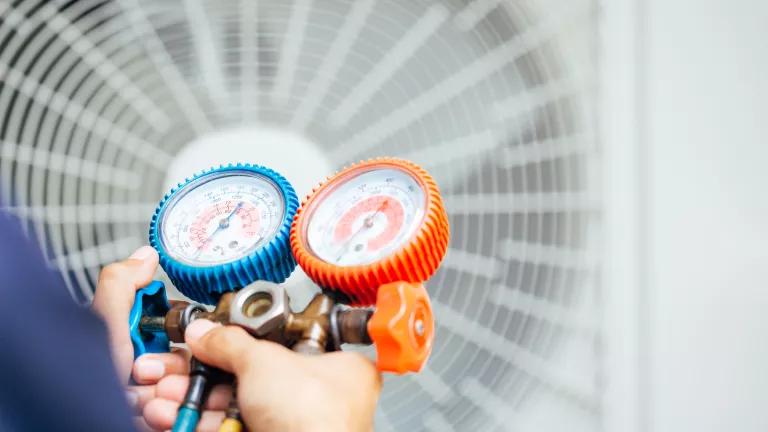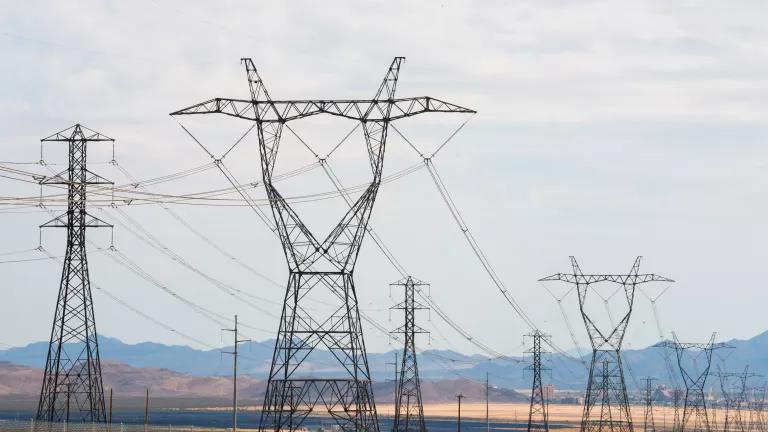California Climate & Energy Policy Update: Summer 2023
California has made strides in reducing emissions, spurred by the increasingly devastating impacts of climate disruption communities across the globe.

Action on climate change is a top priority for Californians, as confirmed in a recent statewide poll. The state’s leaders are meeting the moment: Advancing policy and investments to lead the way toward our targets for carbon neutrality and reducing human-caused greenhouse gas (GHG) emissions to 85 percent below 1990 levels by 2045. Governor Newsom and the Legislature have committed over $50 billion in state funds over several years to address climate change and transition away from fossil fuels, with billions more being considered for a climate bond in 2024.
Below are some recent highlights from the efforts in California to cut emissions and air pollution from buildings, transportation, and the power sector.
Buildings & Affordability
Our homes, schools and community centers present an opportunity to reduce greenhouse gas emissions, save money, and ensure those most burdened by systemic racism and pollution benefit from solutions. California has made progress over the past several years with a range of important building decarbonization policies.
Investments in healthy homes and community buildings: Aligned with the Governor’s commitment to 3 million climate-ready homes by 2030 and the Legislature’s commitment to $1.4 billion for clean, healthy and fossil fuel free buildings, the recently-passed state budget included:
- $432 million for home repairs and installing all-electric appliances in the residences of low-income Californians through the Equitable Building Decarbonization program (totaling $494 million secured over two years, part of a commitment to $922 million over four years).
- $95 million for electric appliance incentives with special provisions for affordable housing through the TECH Clean California program (totaling $145 million secured over two years).
Notably absent was funding for decarbonizing critical community buildings through the Strategic Growth Council (SGC) program. NRDC and allies are now seeking $500 million for this program be included the proposed climate bond. We are also pushing for the passage of SB 795 (to improve the quality of HVAC installations), AB 593 (to reduce emissions from buildings), and SB 567 (to protect tenants who deserve safe and secure affordable housing).
Zero-emissions appliance standard to cut air pollution: The California Air Resources Board (CARB) kicked off its development of a new rule to establish a zero-emission standard for new residential space and water heating appliances starting in 2030, which NRDC and partners support. CARB is now conducting extensive stakeholder outreach to chart an equitable and economic path to the 2030 rule. At the local level, air quality officials in the Bay Area passed the nation's first zero-NOx appliance standards to end the sales of new gas water heaters and furnaces beginning 2027 and 2029. NRDC will be working to ensure that these efforts are connected to existing buildings policies and prioritize benefits for low-income Californians and renters.
Expanded utility shutoff protections for Angelenos: Building off LADWP’s November 2022 decision to end utility shutoffs for low-income customers, RePower LA Coalition partners, Los Angeles Alliance for a New Economy (LAANE) and Strategic Concepts in Organizing and Policy Education (SCOPE), intervened to define when these shutoff protections would apply. LADWP’s board of commissioners voted in June to trigger the protections upon heat or freeze alerts from the National Weather Service. While this is a huge step forward, community partners and NRDC believe there is more work to do – future expansions of this work could include greater protections specific to neighborhoods impacted by the urban heat island effect, full seasonal moratoriums, and protections during severe air quality events when pollution is often concentrated in low-income neighborhoods.
Equitable Rate Reform to improve how we pay for shared electric system costs in California: The California Public Utilities Commission (CPUC) has launched a process to reform electric rates with two primary goals: 1) Equity – more fairly distributing shared electric system costs, and 2) Decarbonization – lowering the price of clean electricity so that customers can make the switch away from gasoline in cars and fossil gas in homes. This includes authorizing an “income-graduated fixed charge” that moves some of the shared costs of the electric grid from energy prices into a monthly fee based on household income. NRDC along with The Utility Reform Network (TURN) submitted a proposal that reduces electricity prices by 20-25% and saves low-income Californians between $10 and $40 each month. State law requires approval of a new rate design by summer 2024; this outcome will be pivotal for enabling all customers to transition to clean, electric technologies in line with climate goals.
Transportation & Mobility
Transportation is the largest source of GHG emissions and hits environmental justice communities the hardest with pollution from cars, trucks, locomotives, and other off-road freight vehicles.
New regulations to combat toxic freight pollution: Building on its Advanced Clean Cars and Clean Trucks rules, CARB adopted two health-transforming regulations strongly supported by NRDC: the Advanced Clean Fleets (ACF) Rule and the In-Use Locomotive Rule. This progress was enabled by decades of tireless advocacy by frontline communities and will accelerate the deployment of zero-emission trucks and cut pollution from locomotives, resulting in cleaner air and a healthier environment for all Californians. Additionally, California came to an agreement with the nation’s leading truck manufacturers to comply with California’s zero-emission vehicle standards regardless of any future challenges to the state’s authority to set more stringent emissions standards under the federal Clean Air Act. NRDC is now working with a large coalition of public interest, environmental, public health, environmental justice, labor, and industry groups to advance legislation (SB 410) designed to ensure that we build the electrical infrastructure needed to enable those vehicle standards.
Emergency funding to protect public transit riders and workers: Facing an anticipated five-year, $5 billion funding shortfall for transit operations, state leaders identified more than $1 billion in new transit funding over three years and maintained $4 billion in state funding committed to the Transit and Intercity Rail Capital Program for two years. This funding will also come with new flexibility to support capital projects or transit operations. As a member of the Survive and Thrive Coalition, NRDC’s advocacy helped secure this flexibility and an additional $3 billion in transit funding relative to the Governor’s January budget proposal. With a multi-billion transit operations funding shortfall remaining, NRDC will continue to work with this coalition to secure the additional funding necessary to achieve our climate and equity goals. NRDC will be supporting, finding ways to use flexible federal infrastructure dollars to fund transit, and reducing transportation spending on polluting highway expansion projects that fail to reduce traffic.
Evolution of the Low Carbon Fuels Standard (LCFS): CARB has opened the door to reimagining the LCFS, an important tool for driving the transition to a cleaner, healthier, and safer transportation sector – but only if CARB ensures LCFS pathways are aligned with California’s climate and environmental justice priorities. A core issue we hope to see CARB address is that over-incentivizing the production of livestock biomethane and crop-based biofuels can cause significant unintended harm, while also diverting resources away from the transition to zero-emissions electric vehicles, as highlighted by many stakeholders including NRDC.
Clean Power
Fundamental to climate progress is ensuring that clean electricity is available, affordable, and reliable for all Californians so that polluting fossil fuels can be displaced by energy from the wind, sun and other clean resources.
Launching offshore wind: To meet California’s long-term decarbonization and electrification goals, the state will need to vastly expand its renewable energy capacity. Offshore wind can play a crucial role: the California Energy Commission (CEC) has established a preliminary planning goal of developing 2–5 GW of offshore wind for 2030 and 25 GW for 2045. NRDC will be closely engaged with the CEC’s work to develop a strategic roadmap to address permitting, the development of supply chains, port development, and transmission – all required to integrate offshore wind into California’s energy system. There is already significant interest in California’s wind resource – the Bureau of Ocean Energy Management (BOEM) last December sold five leases in Morro and Humboldt Bays for a total of $757.1 million. A crucial next step is to set up a central procurement entity that can purchase the large amounts of clean power generated by these projects, which will enable project financing.
Expanding access to community solar + storage: Last year, NRDC partnered with a broad coalition of industry, consumer advocate, labor, and environmental justice stakeholders to pass AB 2316, a community renewables and storage bill to expand access to community solar in the state, especially for low-income residents and renters without rooftop solar. We’re now working with partners to advocate for a tariff that will spur development of projects that combine solar with storage, save customers money, and increase the resiliency of California’s power system. Development of a robust community solar program will fill a large gap in the California market, which has lagged behind other states in community solar development. There’s federal money available through the Inflation Reduction Act that projects can tap into, and we’re advocating with partners for matching state funds to ensure maximum financial benefits for low-income households. Meanwhile, we’re celebrating the recent news that the California grid now has 5600 MW of storage capacity, a more than 10x increase since 2020.
Strategic investments in electric infrastructure: The California Independent System Operator (CAISO) approved a 2022–2023 Transmission Plan that includes $7.3 billion in investments for new and expanded electricity transmission capacity to interconnect a vast array of new clean power generation and storage resources, a key priority for NRDC. This plan is notable for being strategic, proactive, and closely coordinated with California’s energy agencies, reflecting the recent Memorandum of Understanding on transmission between CAISO, CPUC, and CEC. NRDC is engaging with these agencies to ensure rapid and responsible build out of this needed infrastructure.
Progress on Western grid regionalization: A western regional transmission organization would spur the development of clean electricity sources and lower costs for consumers. This month, energy regulators from California, Washington, Oregon, Arizona and New Mexico announced a plan to form a new entity that could manage power across states. NRDC is a leading advocate for a well-designed and fully integrated western grid to accelerate clean energy deployment and cut the cost of sharing renewable energy in the region. We will be closely following and supporting this important step forward and hope to encourage the significant effort needed in the next few years to realize the potential of a regional grid.
Onward!
There is much work still to be done in California to create the healthy and equitable state that we all are working towards, but just this recent progress is worthy of celebration. In the near term, we must secure end-of-session legislative wins and dig in on the implementation of state and federal funding for buildings, electric vehicles, transit, and access to clean power. California has the right stakeholders engaged to make this happen.




